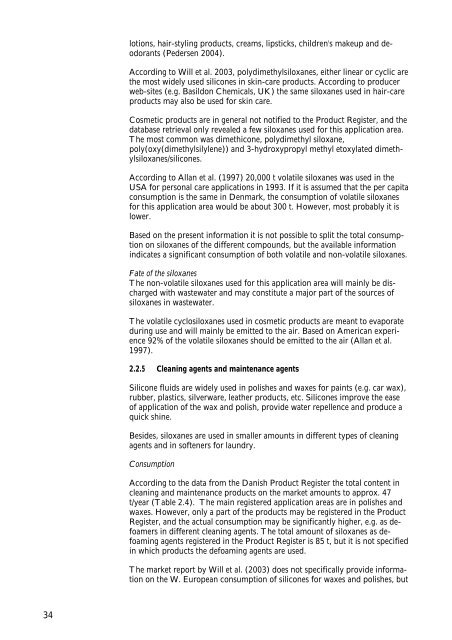Siloxanes - Consumption, Toxicity and Alternatives - Miljøstyrelsen
Siloxanes - Consumption, Toxicity and Alternatives - Miljøstyrelsen
Siloxanes - Consumption, Toxicity and Alternatives - Miljøstyrelsen
Create successful ePaper yourself
Turn your PDF publications into a flip-book with our unique Google optimized e-Paper software.
34<br />
lotions, hair-styling products, creams, lipsticks, children's makeup <strong>and</strong> deodorants<br />
(Pedersen 2004).<br />
According to Will et al. 2003, polydimethylsiloxanes, either linear or cyclic are<br />
the most widely used silicones in skin-care products. According to producer<br />
web-sites (e.g. Basildon Chemicals, UK) the same siloxanes used in hair-care<br />
products may also be used for skin care.<br />
Cosmetic products are in general not notified to the Product Register, <strong>and</strong> the<br />
database retrieval only revealed a few siloxanes used for this application area.<br />
The most common was dimethicone, polydimethyl siloxane,<br />
poly(oxy(dimethylsilylene)) <strong>and</strong> 3-hydroxypropyl methyl etoxylated dimethylsiloxanes/silicones.<br />
According to Allan et al. (1997) 20,000 t volatile siloxanes was used in the<br />
USA for personal care applications in 1993. If it is assumed that the per capita<br />
consumption is the same in Denmark, the consumption of volatile siloxanes<br />
for this application area would be about 300 t. However, most probably it is<br />
lower.<br />
Based on the present information it is not possible to split the total consumption<br />
on siloxanes of the different compounds, but the available information<br />
indicates a significant consumption of both volatile <strong>and</strong> non-volatile siloxanes.<br />
Fate of the siloxanes<br />
The non-volatile siloxanes used for this application area will mainly be discharged<br />
with wastewater <strong>and</strong> may constitute a major part of the sources of<br />
siloxanes in wastewater.<br />
The volatile cyclosiloxanes used in cosmetic products are meant to evaporate<br />
during use <strong>and</strong> will mainly be emitted to the air. Based on American experience<br />
92% of the volatile siloxanes should be emitted to the air (Allan et al.<br />
1997).<br />
2.2.5 Cleaning agents <strong>and</strong> maintenance agents<br />
Silicone fluids are widely used in polishes <strong>and</strong> waxes for paints (e.g. car wax),<br />
rubber, plastics, silverware, leather products, etc. Silicones improve the ease<br />
of application of the wax <strong>and</strong> polish, provide water repellence <strong>and</strong> produce a<br />
quick shine.<br />
Besides, siloxanes are used in smaller amounts in different types of cleaning<br />
agents <strong>and</strong> in softeners for laundry.<br />
<strong>Consumption</strong><br />
According to the data from the Danish Product Register the total content in<br />
cleaning <strong>and</strong> maintenance products on the market amounts to approx. 47<br />
t/year (Table 2.4). The main registered application areas are in polishes <strong>and</strong><br />
waxes. However, only a part of the products may be registered in the Product<br />
Register, <strong>and</strong> the actual consumption may be significantly higher, e.g. as defoamers<br />
in different cleaning agents. The total amount of siloxanes as defoaming<br />
agents registered in the Product Register is 85 t, but it is not specified<br />
in which products the defoaming agents are used.<br />
The market report by Will et al. (2003) does not specifically provide information<br />
on the W. European consumption of silicones for waxes <strong>and</strong> polishes, but

















